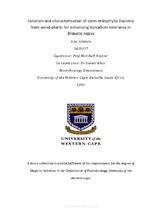| dc.description.abstract | Bacterial endophytes are able to improve the growth of their hosts through a number of
different mechanisms such as nutrient uptake regulation, plant hormone production and
regulation, siderophore production and phosphate solubilisation. They have also been shown
to be able to provide protection to plants against various abiotic stressors, through various
means such as oxidative stress protection. The purpose of this study was therefore to isolate
endophytic bacteria from the stems of different weeds, to characterize their ability to use
some of the most important growth promoting mechanisms including the ability to produce
IAA, siderophores and ACC deaminase, what effect they had on the nutrient uptake in their
hosts and to determine to what extent they could promote growth in the roots, stems and
leaves of Brassica napus plants. In addition to this the endophytes were tested to see to what
extent they could protect Brassica napus from the negative effects of vanadium stress and
how this affected the plant physiologically in terms of morphology, overall biomass, the plants
nutrient profile, lipid peroxidation and levels of cell death. The effect of vanadium stress on
the oxidative state of Brassica napus was also monitored by determining the levels of stress
induced reactive oxygen species (ROS) and the corresponding antioxidants that are
responsible for regulating these reactive oxygen species.
Six different endophytes (P1, P2, P3, P4, P5, P6) were isolated from different weed samples.
Each endophyte was found to be able to significantly improve germination and growth in their
host plant. Each isolate was able to improve the uptake of certain macronutrients and
micronutrients in their respective hosts, while all of the isolates were shown to be capable of
producing siderophores and ACC deaminase. One isolate had high levels of IAA production,
with the remaining isolates producing small amounts of IAA. All isolates were also unable to
solubilize phosphate.
The five best performing endophytes (P1, P2, P3, P5, P6) in the preliminary growth trials were
used in the follow up vanadium stressed growth trials, with endophyte P4 being left out of
the remaining experiments. All of the endophytes showed improvements in growth
promotion in comparison to the control, with endophyte treated plants showing both
increased growth and biomass in both the non-stressed and vanadium stressed treatments
of the vanadium stressed growth trial; however, the leaves of the vanadium stressed plants
were significantly smaller than their non-stressed counterparts. When looking at the oxidative
state it was found that vanadium stress caused a significant increase in the development of
O2
-, H2O2 and •OH in the control and in addition to this it was shown that treatment with
endophytes was able to cause a significant decrease in the levels of stress induced H2O2 and
•OH in all of the treatments and O2
- for plants treated with endophyte P5. The noted change
in the oxidative state of endophyte treated plants was attributed to an increase in the
antioxidant activity of these plants, as it was found that endophyte treated plants showed a
combination of increased activity for Superoxide dismutase, catalase and ascorbate
peroxidase.
This study has shown that endophytic bacteria from plant stems can be used to improve crop
growth and yield, while simultaneously producing more nutrient dense crops from the same
amount of land. It has also determined that endophytes P1, P2, P3, P5 and P6 are able to
successfully provide protection to crop plants from the harmful effects of exposure to
vanadium stress. This has great potential for improving food security locally and around the
world, by allowing those who cannot gain access to large amounts of food to take in more
nutrients from the same amount of food. Furthermore, it also presents the opportunity to
use endophyte treatments to grow crops on land that has been previously contaminated with
certain heavy metals. | en_US |

